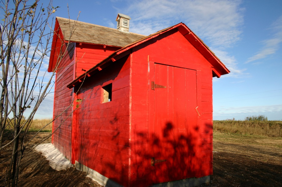Albert E. Smith came to the Elm Valley District with
his parents and other family members in 1888. For a short while, he
delivered meat throughout the country from the farm but in 1899, he
established a butcher shop in Reston. Except for a short time in the
early 1900's (1907-1910) when he returned to his farm, he operated his
Reston butcher shop for fifty-one years.
Albert was the seventh of nine children born to James and Jane Smith
(nee Duncan) who came from Lanark County, Ont., when he was 13
then. He filed for a homestead of his own when he was 16. Besides
farming, he took up the butchering trade, delivering meat from his farm
and assisting a number of beef rings. In 1899 when he was 25, he
established a meat market in Reston. In the meantime, he had also
developed an insurance agency, which became his major business interest.
One of A. E. Smith's personal projects was the improvement of the local
cemetery. Evidently, some hasty burials during the flu epidemic of
1919-20 had aggravated disorganization at the graveyard. Smith brought
strict regularity into the operation of the cemetery during his tenure
as secretary-treasurer of the burial society. Headstones were
straightened plots laid out precisely; records kept up-to-date. Perhaps
most notably, Smith brought small spruce trees from Riding Mountain
National Park and planted these where no trees grew before, giving the
Reston Cemetery its distinctive appearance ever since.
The Butcher Shop
At first he used an old office, which had been used in the first years
as the municipal office. He quickly turned the site into a proper
butcher shop and here he operated until the fire of 1916, which
destroyed much of the east side of Main Street.
He promptly set about building a new and better shop, a two story brick
structure with a lean-to on the north side to house the Soon
Restaurant. In June 1916, though the building was not complete, he was
back there in business.
After fifty-one years in business, Mr. Smith sold his butcher shop in
1950 but for a time continued in his insurance, which along with work
in the Pipestone Municipal Council and other public duties, had more
and more occupied his time as years
had gone by. It was because he always had able assistants in his shop
that he was able to take time for so many public duties.
His advertisements in the Reston Recorder were always interesting and
filled with philosophy. An example was, "Yes, we have a very fine town
and we also have a very fine meat market — but both can be improved."
In 1908, he was advertising sirloin steaks at twelve and a half cents a
pound. He also supplied the town with exotic meats for on Christmas,
1926, he was offering buffalo meat and dill
pickles to go with it.
Adapted from Trails Along the Pipestone, page
494, 601
A Beef Ring Building

In his youth in the Elm Valley district Alex would assist at a number
of beef rings.
A beef ring facilitated the co-operative efforts of a rural community
to ensure a supply of fresh beef in times before refrigerated storage
was available. Each week during the summer a member of the Beef Ring
supplied a steer to be kept overnight in the holding stall, killed and
butchered in the compact but ingeniously equipped main room and then
shared. Essentially a small slaughterhouse, like this structure in
Gilbert Plains, completed in 1923, the utilitarian building thus belies
its internal inventiveness: like the inclusion of a holding stall
separate from the killing floor, the large wooden built-in hoist for
lifting the carcass, a metal ring embedded in the concrete floor to
secure the animal before slaughter, and the row of large nails along
two walls, each numbered, where the members’ portions of beef were
placed in sugar sacks.
Beef rings played an important role in rural food supply until the
advent of home freezers and locker plants in the1940’s.
|





